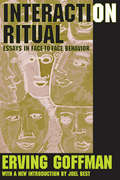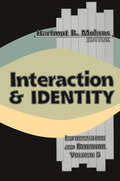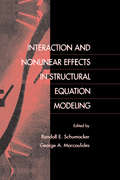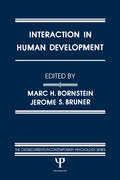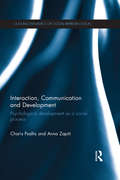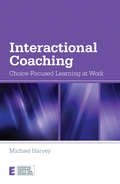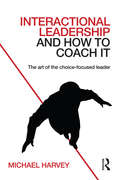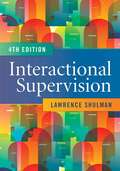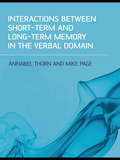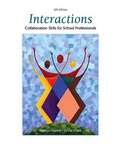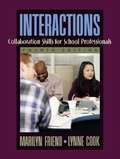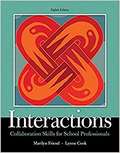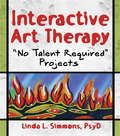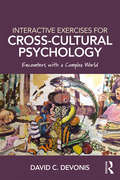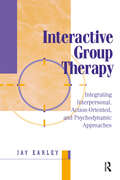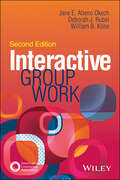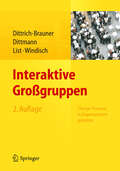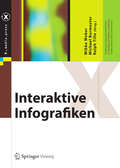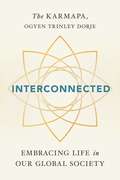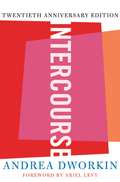- Table View
- List View
Interaction Ritual: Essays in Face-to-Face Behavior
by Erving Goffman"Not then, men and their moments. Rather, moment and their men," writes Erving Goffman in the introduction to his groundbreaking 1967 Interaction Ritual, a study of face-to-face interaction in natural settings, that class of events which occurs during co-presence and by virtue of co-presence. The ultimate behavioral materials are the glances, gestures, positionings, and verbal statements that people continuously feed into situations, whether intended or not.A sociology of occasions is here advocated. Social organization is the central theme, but what is organized is the co-mingling of persons and the temporary interactional enterprises that can arise therefrom. A normatively stabilized structure is at issue, a "social gathering," but this is a shifting entity, necessarily evanescent, created by arrivals and killed by departures. The major section of the book is the essay "Where the Action Is," drawing on Goffman's last major ethnographic project observation of Nevada casinos.Tom Burns says of Goffman's work "The eleven books form a singularly compact body of writing. All his published work was devoted to topics and themes which were closely connected, and the methodology, angles of approach and of course style of writing remained characteristically his own throughout. Interaction Ritual in particular is an interesting account of daily social interaction viewed with a new perspective for the logic of our behavior in such ordinary circumstances as entering a crowded elevator or bus." In his new introduction, Joel Best considers Goffman's work in toto and places Interaction Ritual in that total context as one of Goffman's pivotal works: "His subject matter was unique. In sharp contrast to the natural tendency of many scholars to tackle big, important topics, Goffman was a minimalist, working on a small scale, and concentrating on the most mundane, ordinary social contacts, on everyday life.'"
Interaction and Identity
by Harmut B. MokrosScholarly interest in issues of self-identity has exploded across disciplines within the humanities and social sciences in recent years. Common to these concerns are the assumptions that self-identity is not an a priori, not given or fixed, but created in the process of communication. This also assumes that social institutions and values are produced and reproduced by individuals in interaction. To capture the essential characteristics of a person requires analysis of how the social and psychological intersect in moments of communication.Interaction and Identity contributes, theoretically and empirically, to contemporary scholarly interest in issues of identity. Chapters and contributors to this stand alone volume include: "Part/Whole Discovery: Stages of Inquiry" by Thomas Scheff; "Communication" by Gregory Bateson; "Internal Muzak: An Examination of Intrapersonal Relationships" by Linda Lederman; "The Constitution of Identity as Gendered in Psychoanalytic Therapy: Ideology and Interaction" by Margaret Carr; and "The (Reconstruction and Negotiation of Cultural Identities in the Age of Globalization" by Getinet Belay.The multiple disciplines of social research with contemporary interest in identity are ably reflected in Interaction and Identity. The authors are drawn from eight disciplines: anthropology, communication, information science, linguistics, philosophy, psychoanalysis, psychology, and sociology. This book will be invaluable to scholars in all these areas—above all in communication research as such.
Interaction and Nonlinear Effects in Structural Equation Modeling
by George A. Marcoulides Randall E. SchumackerThis volume provides a comprehensive presentation of the various procedures currently available for testing interaction and nonlinear effects in structural equation modeling. By focusing on various software applications, the reader should quickly be able to incorporate one of the procedures into testing interaction or nonlinear effects in their own model. Although every attempt is made to keep mathematical details to a minimum, it is assumed that the reader has mastered the equivalent of a graduate-level multivariate statistics course which includes adequate coverage of structural equation modeling. This book will be of interest to researchers and practitioners in education and the social sciences.
Interaction in Human Development (Crosscurrents in Contemporary Psychology Series)
by Jerome S. Bruner Marc H. BornsteinInteraction in Human Development unites theoretical essays and empirical accounts bearing directly on the nature of interactions as a principal factor and organizing feature in human mental and social development. The papers discuss all areas of interaction including genetic, environmental, life-span, interpersonal, and cultural. Ideal as a text for students and as a reference for professionals in personality, developmental, educational, and environmental psychology, psychotherapy, behavioral medicine, and language.
Interaction, Communication and Development: Psychological development as a social process (Cultural Dynamics of Social Representation)
by Charis Psaltis Anna ZapitiFor decades there has been considerable interest in the ways that interactions between children can provide a beneficial context for the study of cognitive and social development. In this book Psaltis and Zapiti use both theoretical and empirical research to build on the perspectives of Piaget, Vygotsky, Moscovici, and others including the legacy of Gerard Duveen, to offer a state of the art account of research on the themes of social interaction and cognitive development. Interaction Communication and Development discusses the significance of social identities for social interaction and cognitive development. The empirical set of studies presented and discussed focus on patterns of communication between children as they work together to solve problems. Communications are examined in detail with a focus on: Socio-cognitive conflict, conversational moves and conversation types The way the different forms of the interactions relate to different sources of asymmetry in the classroom The way social representations and social identities of gender are negotiated in the interaction This book provides an important account of how children develop through different kinds of social interactions. It will have considerable appeal for researchers in the fields of developmental psychology, socio-cultural psychology, social representations theory and education who wish to gain a deeper understanding of development and its relation to socio-cultural processes.
Interactional Coaching: Choice-focused Learning at Work (Essential Coaching Skills and Knowledge)
by Michael HarveyInteractional Coaching is a powerful, one-to-one learning approach, used successfully for over fifteen years, that enables executives to make the choices that work for them. Drawing on existential philosophy, psychotherapy and business theory, interactional coaching uses innovative techniques to help clients identify their best possible choices and effectively put them into practice. Featuring numerous case studies, which integrate theoretical principles with practical tools, Interactional Coaching illustrates: coaching for vision and other time-related issues coaching in the personal dimension coaching interactional strategy and skills coaching conflicts and dilemmas coaching creativity and communication coaching leadership and managerial expertise. Interactional Coaching is essential reading for anyone interested in a new, comprehensive approach to helping coachees develop the self-knowledge and interpersonal skills necessary for achievement in today's workplace.
Interactional Leadership and How to Coach It: The art of the choice-focused leader
by Michael HarveyAll leaders make choices, but not all leaders are choice-focused. In Interactional Leadership and How to Coach It: The art of the choice-focused leader Michael Harvey presents an important new theory of leadership which demonstrates how to coach successful choice-making. This clear, wide-ranging book integrates business and psychology, exploring the art of choice-focused leadership through neuroscience, cognitive psychology, existential philosophy and leadership studies. Interactional leadership helps leaders to make informed decisions throughout the "achievement cycle" of strategy, resourcing and delivery, and emphasises the importance of psychological balance. The book features chapter-long case studies which provide unique insights into the leader’s inner world and clearly illustrate how the tightrope of leadership can be mastered. Harvey draws important lessons about decision-making from corporate leaders, politicians and even Shakespeare’s tragic heroes, and addresses the leader’s ethical responsibility for major issues facing us now and in the future. The interactional model also focuses on coaching the multiple roles of leadership, such as global leader, team leader, innovator, entrepreneur and chair of the board. Accessible and practical, Interactional Leadership and How to Coach It is an ideal guide for coaches, leaders, students, trainers of coaches and anyone involved in leadership development and recruitment.
Interactional Supervision
by Lawrence ShulmanInteractional supervision models explained, applying supervision during the phases of work, education and evaluation roles of the supervisor, and working with staff groups.
Interactional Supervision
by Lawrence ShulmanClinical supervision is fraught with difficulties, and those who transition from frontline worker to supervisor often receive little training or support, particularly when it comes to the interpersonal skills needed for implementing complex human relations tasks. Left to their own devices, clinical supervisors must navigate myriad challenges like these real-world examples: <p><p>A supervisor decided that the evaluation process would be a good time to level with a long-term staff member about his inadequate performance. She reviewed the staff member s personnel record and discovered that previous supervisors had given the employee consistently positive and obviously false evaluations. She dreaded the approaching conference, expecting the worker to be angry. <p><p>A supervisor was asked by her administrator to back her up when staff were notified of budget cuts that would result in pay cuts and heavier caseloads. At a team meeting, one worker, who appeared to be speaking for the rest, said to the supervisor, You are going to be with us on this one, aren't you? <p><p>A recently promoted Black supervisor heard that many members of the largely White staff thought he had obtained the promotion because of the agency s affirmative action program. Nothing was said directly; however, he could sense tension in the staff group. He felt angry, hurt, and bitter at the racist element in his reception and increasingly isolated at the agency. <p><p>Drawing on decades of his own experience and the experiences of those he has trained, Lawrence Shulman provides clear, simple models of supervision using a conversational tone and practical advice in this must-have resource. <p><p>Every phase of supervision is discussed in detail, with a focus on communication, making demands for work, facing taboo subjects, and transitioning into and out of roles and relationships. Strategies for group work and meetings include everyday challenges; trauma, such as client deaths; violence against frontline workers; and cutbacks. Supervisors will learn how to apply Shulman s parallel process framework in their interactions with frontline workers to model ideal interactions between workers and their clients. <p><p>In this fourth edition, evidence-based practices and interventions are updated to include the latest ethical and legal aspects of supervision and also feminist; lesbian, gay, bisexual, transgender, queer, and questioning; and trauma-informed practice.
Interactions Between Short-Term and Long-Term Memory in the Verbal Domain
by Annabel Thorn Mike PageThe relationship between short-term and long-term memory systems is an issue of central concern to memory theorists. The association between temporary memory mechanisms and established knowledge bases is now regarded as critical to the development of theoretical and computational accounts of verbal short-term memory functioning. However, to date there is no single publication that provides dedicated and full coverage of current understanding of the association between short-term and long-term memory systems. Interactions between Short-Term and Long-Term Memory in the Verbal Domain is the first volume to comprehensively address this key issue. The book, focusing specifically on memory for verbal information, comprises chapters covering current theoretical approaches, together with the very latest experimental work, from leading researchers in the field. Chapters contributed to the book draw on both cognitive and neuropsychological research and reflect both conceptual and computational approaches to theorising. The contributing authors represent current research perspectives from both sides of the Atlantic. By addressing this important topic head-on, Interactions between Short-Term and Long-Term Memory in the Verbal Domain represents an invaluable resource for academics and students alike.
Interactions: Collaboration Skills for School Professionals
by Marilyn Friend Lynne CookTargeted at services for students with special needs, this text provides collaboration techniques between educators fraternity - special educators, general educators and related services professionals - to work towards effective communication framework.
Interactions: Collaboration Skills for School Professionals (4th Edition)
by Marilyn Friend Lynne CookInteractions, Fourth Edition, provides a cutting-edge look at how teams of school professionals-classroom teachers, special education teachers, and counselors-can effectively work together to provide a necessary range of services to students with special needs. This book addresses collaboration as a style, with accompanying knowledge and skills, which guides practices in many education efforts. As a result, future teachers learn how to collaborate with school professionals and families to help special education students who are more often being placed in general classroom settings.
Interactions: Collaboration Skills for School Professionals (Eighth Edition)
by Marilyn Friend Lynne CookWe intend for the book to be a useful tool for preservice educators and practitioners in improving their skills and deepening their understanding, whether they are engaged in formal instructional settings, study groups, or independent study.
Interactive Art Therapy: No Talent Required Projects
by Linda L. SimmonsWork with your client-using an effective multi-sensory techniqueMost people are visual learners. Seeing our ideas in pictures gives them greater impact and more meaning. Interactive Art Therapy: "No Talent Required" Projects presents a cutting-edge therapeutic technique founded on sound clinical principles, providing another practical tool any therapist or counselor can effectively use without anyone having to be a da Vinci. The book clearly discusses the clinical rationale behind using standard drawings in therapy and demonstrates how the interactive nature of the approach helps clients to quickly and easily gain deeper insight.Interactive Art Therapy: "No Talent Required" Projects helps counselors and therapists empower the client to become an active participant in the therapeutic process, allowing the flexibility of the drawings to be adaptive to the client&’s cognitive and developmental abilities. The book examines ways for practitioners to discern whether Interactive Art Therapy is a suitable clinical intervention for the client, then explores the ways each drawing can be used to help clients move toward breakthroughs in their therapy. The text uses case examples to clearly illustrate techniques and reveal the ways that clients&’ drawings reflect their thought processes.Interactive Art Therapy: "No Talent Required" Projects discusses how to use simple, client-friendly drawings such as: "Cage of Fears" "Teeter-Totter of Decision-Making" "The Coping Arch" "Boundary Castle" "Well of Needs" "Weight of the World" "Swamp of Sympathy" "Brick Wall of Barriers" "The Pressure Box" "Pole Vault for Goals"Interactive Art Therapy: "No Talent Required" Projects provides a valuable tool for therapists, school psychologists, guidance counselors, psychiatrists, marriage and family counselors, drug and alcohol counselors, pastoral counselors, educators, and students.
Interactive Exercises for Cross-Cultural Psychology: Encounters With a Complex World
by David C DevonisInteractive Exercises for Cross-Cultural Psychology provides material for interactive discussion of a range of topics in cross-cultural psychology, including regional and indigenous psychology; symbolic and expressive psychology; identity; social perception and cognition; interpersonal interaction; emotion, motivation, and health; development and family; government and law; economics and work; environmental psychology; animals and other species; and the psychology of recreation and sport. It will help students apply cultural psychology to social issues, and makes these issues relevant to students in health, forensic, organizational, sport and exercise, and other applied psychology fields. It offers suggestions for exposition, simulation, and confrontation of important cultural issues that matter to students, while allowing for maximum creativity in instructional design. Thoroughly and currently referenced, with connections to a wide range of accessible web-based and open-source materials, it is user-friendly across a spectrum of classroom and workshop applications, including online delivery.
Interactive Group Therapy: Integrating, Interpersonal, Action-Orientated and Psychodynamic Approaches
by Jay EarleyFirst published in 2000. Routledge is an imprint of Taylor & Francis, an informa company.
Interactive Group Work
by Deborah J. Rubel Jane E. Atieno Okech William B. KlineA comprehensive and efficient guide for both novice and experienced group leaders, Interactive Group Work helps group leaders to create the conditions across group types and settings that enable group members to support one another. From group work principles to theories and procedures, this text focuses on group counseling and therapy and explores the shared foundations with psychoeducational and task groups. Through in-depth explanations and real-world examples, it illustrates how groups work and builds knowledge of how to create successful group environments—places where group members interact, grow, change, and achieve their goals. This book goes in depth on how to set the stage for group work and enhance the experience for leaders and clients. A supplemental Instructor’s Manual of test questions is available by request from ACA. Requests for digital versions from ACA can be found here. To purchase print copies, please visit the ACA website here Reproduction requests for material from books published by ACA should be directed to permissions@counseling.org
Interactive Music Therapy - A Positive Approach: Music Therapy at a Child Development Centre
by Amelia Oldfield Fatima JanjuaIn Interactive Music Therapy - A Positive Approach, Amelia Oldfield explains how her approach to music therapy sessions establishes a constructive musical dialogue with children that emphasises positive experiences - these establish trust and allow feelings to be expressed through music. Describing the general benefits of this approach, the author also details its application for specific clinical groups including children with autistic spectrum disorders, relationship difficulties or physical disabilities. Individual chapters focus specifically on child development issues and in child and brief case studies throughout the text illustrate points of particular importance. This practical book will be of use to other clinicians and teachers working with children with a variety of needs, including children on the autism spectrum and children with learning disabilities. It is also of use to music therapy trainers, their students and academics whose interests include music therapy.
Interactive Music Therapy in Child and Family Psychiatry: Clinical Practice, Research and Teaching
by Amelia Oldfield Jo Holmes'What is truly distinctive about this book is that Oldfield introduces her doctoral research, in which she created the Music Therapy Diagnostic Assessment (MTDA) in comparison to one of the most internationally recognized standardized diagnostic tool.' - Autism Diagnostic Observation Schedule (ADOS). 'I believe that the book will be useful for music therapy students, and novice music therapist working in child and family psychiatry and related fields.' - Nordic Journal of Music Therapy 'In her indomitable, accessible and straightforward style, Amelia Oldfield continues to champion the use of music therapy with families in her most recent publication. The book is in many ways a step-by-step music therapy manual, informing us of music therapy methods and innovations and provoking new thoughtfulness for work within the child mental health setting.' - Journal of Family Therapy 'This book could be an invaluable resource for readers who are looking for evidence that music therapy can have a very positive effect on certain disorders and family dynamics. I could imagine it would bring great hope for those whose children find communication very difficult, or where families are struggling to relate emotionally. The book [also] has a lot of clinical research data, which would be extremely useful for students or clinicians needing to validate this kind of work.' - ACCord Magazine 'This practical book outlines and explains the rationale for using music therapy in child and family psychiatry. Amelia Oldfield reflects on current research methodology and describes characteristics of her own approach to therapy sessions, including how to start and end the session, how to motivate children and establish a positive musical dialogue with them, and how to include parents in the session. She also uses video analysis techniques to assess and advance the role of the therapist. Individual chapters focus on the results of the author's research investigations with specific groups such as mothers and young children, groups of adults with profound difficulties, children with autistic spectrum disorder or severe physical and mental difficulties, as well as children without clear diagnosis. Case studies and vignettes supplement these examples. The author also considers the whole process from the initial referral for therapy and using psychiatric music therapy for diagnostic assessment to how to end treatment. This book is accessible to music therapists, psychiatrists, nurses and occupational therapists working with children and families, as well as music therapy trainers, their students and academics interested in music therapy.' - British Society for Music Therapy 'Those who are specifically interested in music therapy as applied to children and families will find no better mentor than Oldfield.' - Mental Health Care Practice 'Well, this book was a pleasant surprise! I found it a remarkably uplifting read. Amelia Oldfield describes in detail how she has managed to interact through music with children (and adults) with a wide range of significant difficulties, intellectual, emotional and physical. Her music therapy is intended to help with diagnosis but she also involved parents and carers in her sessions in a way which helps them to come to terms with and deal more comfortably with their charges.' - Adoption.net This practical book outlines and explains the rationale for using music therapy in child and family psychiatry. Amelia Oldfield reflects on current research methodology and describes characteristics of her own approach to therapy sessions, including how to start and end the session, how to motivate children and establish a positive musical dialogue with them, and how to include parents in the session. She also uses video analysis techniques to assess and advance the role of the therapist. Individual chapters focus on the results of the author's research investigations with specific groups such as mothers and young children, groups of adults with profound difficulties, children with autistic spectrum disorder or severe phy...
Interactive Processes in Reading (Psychology Library Editions: Psychology of Reading #6)
by Alan M. Lesgold and Charles A. PerfettiOriginally published in 1981, this volume is the edited proceedings of a conference held at the Learning Research and Development Center of the University of Pittsburgh in September 1979. The 15 chapters share a number of common issues. These include the role of contextual influences on lexical access, specific models of lexical access and word pronunciation, speech and visual processes in reading, the role of knowledge in comprehension, and sources of skill difference and skill development.
Interaktionsspiele bei Psychopathie: Antisoziale Manipulation erkennen und konstruktiv bewältigen (Psychotherapie: Praxis)
by Rainer Sachse Fritjof von FranquéIm vorliegenden Buch wird beschrieben, wie manipulatives Handeln von Personen mit Psychopathie erkannt und bewältigt werden kann. Die psychopathische Persönlichkeitsstörung (engl.: Psychopathy) ist definiert durch eine Kombination aus interaktionellen, affektiven, antisozialen und sich im Lebensstil ausdrückenden Besonderheiten, zu denen Egozentrizität, manipulierendes Verhalten, ein Mangel an Mitgefühl, Schuld und Reue, pathologisches Lügen, Verantwortungslosigkeit sowie die kontinuierliche Verletzung sozialer Normen und Erwartungen zählen. Fachleute haben vor allem Schwierigkeiten, mit den interpersonellen Merkmalen dieser Störung umzugehen. Dieses Buch bietet hierfür konkrete Unterstützung. Geschrieben für … Psychotherapeuten, Coaches, Diagnostiker, Psychiater, forensische Psychologen und alle, die beruflich mit Psychopathen zu tun haben. Die Autoren: Prof. Dr. Rainer Sachse ist Psychologischer Psychotherapeut, Begründer der „Klärungsorientierten Psychotherapie“ und Leiter des Instituts für Psychologische Psychotherapie (IPP) in Bochum. Fritjof von Franqué ist sexualforensischer Psychotherapeut und leitender Psychologe am Institut für Sexualforschung und Forensische Psychiatrie des Universitätsklinikums Hamburg-Eppendorf (UKE).
Interaktive Großgruppen: Change-Prozesse in Organisationen gestalten
by Carmen Windisch Volker List Karin Dittrich-Brauner Eberhard DittmannOrganisationen und ihre Mitarbeiter verändern sich fortlaufend und lernen dazu, um konkurrenzfähig zu bleiben. Zu diesem Zweck setzen Unternehmen immer häufiger Großgruppenverfahren ein, denn diese haben klassischen Workshopmethoden einiges voraus: Sie erzeugen Bewegung, initiieren Kontakte und Diskussionen, fördern die Identifikation und garantieren die Nachhaltigkeit von Veränderungen in Organisationen - kurz: sie binden auf aktive und effektive Weise viele Menschen in einen gemeinsamen Entwicklungsprozess ein. Die Arbeit mit großen Gruppen ist gleichzeitig zielführend und unterhaltsam. Alles drin: Zum einen "klassische Verfahren" wie Zukunftskonferenz, Open Space, Appreciative Inquiry, RTSC, World Café, sowie deren Entwicklung, Einsatzgebiete, Ablauf und Nutzen. Zum anderen Weiterentwicklungen und Trends, neue Anforderungen, integrative Ansätze, Einbindung neuer Technologien u.v.m., sowie Tipps zur Dramaturgie in Großgruppen. Direkt loslegen: Mit konkreten Tipps, Checklisten, Experteninterviews, Fallbeispielen und Erfahrungsberichten aus bekannten Unternehmen, Hinweisen zu speziellen Einsatzmöglichkeiten von Großgruppenverfahren und, damit nichts schiefgeht, Vorbereitungs-Tipps zu Räumlichkeiten, Ton, Visualisierung, Dokumentation und Zeitplanung. Die zweite Auflage wurde aktualisiert und um aktuelle Themen (u.a. Social Media, Großgruppen in Veränderungsprojekten) ergänzt.
Interaktive Infografiken
by Michael Burmester Ralph Tille Wibke WeberIn einer Welt der Multimedialität gewinnt ein Visualisierungstyp zunehmend an Bedeutung: die interaktive Infografik. Sie wird im Journalismus ebenso eingesetzt wie in der Unternehmenskommunikation. Dieses Buch führt auf Grundlage aktueller Forschungserkenntnisse in Theorie, Design und Rezeption von interaktiven Infografiken ein: Wie werden sie wahrgenommen? Welche Vorteile bieten sie für das Verstehen und Behalten von Inhalten? Gibt es Gestaltungs- und Erzählmuster? Welche Methoden wenden Infografiker an? Mit Beispielen und Tipps von Experten.
Interconnected: Embracing Life in Our Global Society
by Ogyen Trinley KarmapaPlucked from a humble nomad family to become the leader of one of Tibet’s oldest Buddhist lineages, the young Seventeenth Karmapa draws on timeless values to create an urgent ethic for today’s global community. We have always been, and will always be, interconnected—through family, community, and shared humanity. As our planet changes and our world grows smaller, it is vital we not only recognize our connections to one another and to the earth but also begin actively working together as interdependent individuals to create a truly global society. The Karmapa, Ogyen Trinley Dorje, is uniquely positioned to guide us in this process. Drawing on years of intensive Buddhist training and a passionate commitment to social issues, he teaches how we can move from a merely intellectual understanding to a fully lived experience of connection. By first seeing, then feeling, and finally living these connections, we can become more effective agents of social and ethical change. The Karmapa shows us how gaining emotional awareness of our connectedness can fundamentally reshape the human race. He then guides us to action, showing step by step how we can change the way we use the earth’s resources and can continue to better our society. In clear language, the Karmapa draws connections between such seemingly far-flung issues as consumer culture, loneliness, animal protection, and self-reliance. In the process, he helps us move beyond theory to practical and positive social and ethical change.
Intercourse
by Andrea DworkinAndrea Dworkin, once called "Feminism’s Malcolm X,” has been worshipped, reviled, criticized, and analyzed-but never ignored. The power of her writing, the passion of her ideals, and the ferocity of her intellect have spurred the arguments and activism of two generations of feminists. Now the book that she’s best known for-in which she provoked the argument that ultimately split apart the feminist movement-is being reissued for the young women and men of the twenty-first century. Intercourse enraged as many readers as it inspired when it was first published in 1987. <P><P> In it, Dworkin argues that in a male supremacist society, sex between men and women constitutes a central part of women’s subordination to men. (This argument was quickly-and falsely-simplified to "all sex is rape” in the public arena, adding fire to Dworkin’s already radical persona. ) In her introduction to this twentieth-anniversary edition of Intercourse, Ariel Levy, the author of Female Chauvinist Pigs, discusses the circumstances of Dworkin’s untimely death in the spring of 2005, and the enormous impact of her life and work. Dworkin’s argument, she points out, is the stickiest question of feminism: Can a woman fight the power when he shares her bed?
